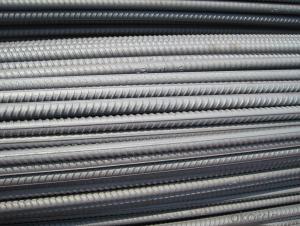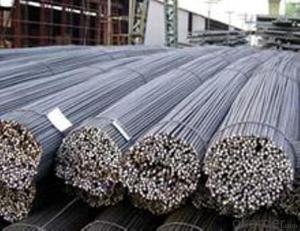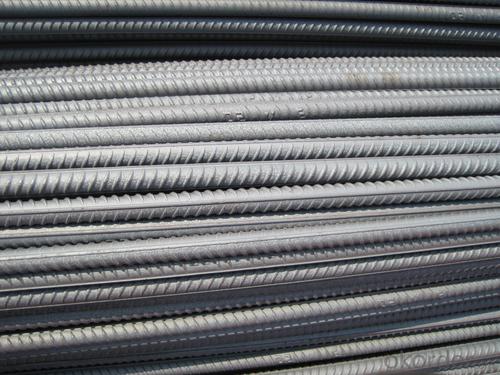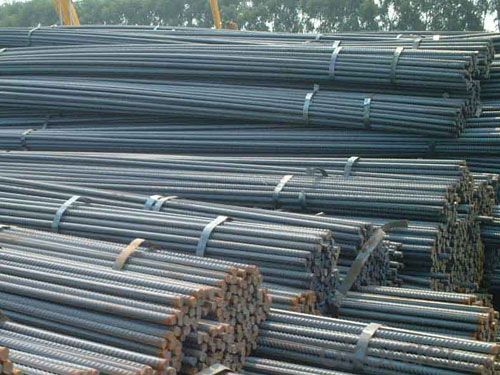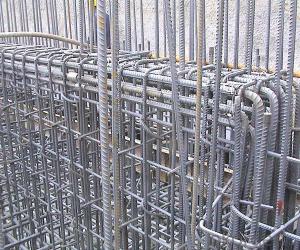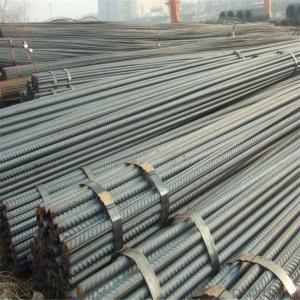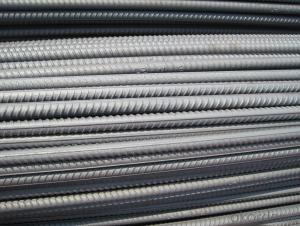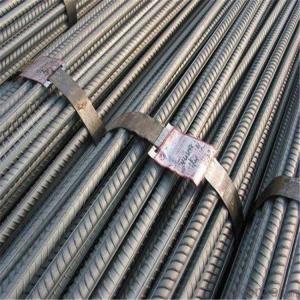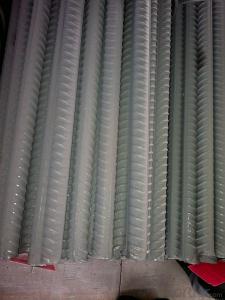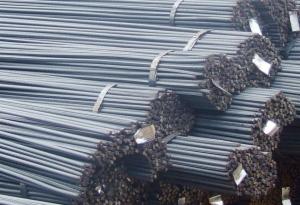BS4449 G460 Reinforcing Deformed Steel Bar, Rebar, Deformed Rebar
- Loading Port:
- Shanghai
- Payment Terms:
- TT OR LC
- Min Order Qty:
- 100 m.t.
- Supply Capability:
- 1000 m.t./month
OKorder Service Pledge
OKorder Financial Service
You Might Also Like
deformed steel bar grade 40
material: HRB400, BS4449 GR460B
size: 8-36mmx12m.
short delivery time by bulk or container
deformed steel bar grade 40
material: HRB400, BS4449 GR460B
size: 8-36mmx12m.
short delivery time with bulk or container
packing: Mill standard export packing in bundles/coil, around 2tons/bundle.
country of Origin: China
delivery Time: Within a 35 days
Shipment: by bulk vessel or by container
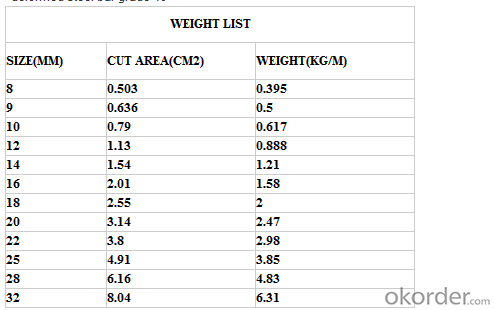
Leading goods:
section steel:angles,channels,I-beam,H-beam;
coils:cold/hot rolled coils,PPGI,galvanized coils,plate,checkered plate,cutting steel plate,steel strip;
wire rod:steel wire,deformed wire,bar;
pipe:seamless pipe,rectangular pipe,welded pipe,spiral welded pipe,pipe fittings;
stainless steel:steel sheets,stainless steel strips,stainless bar,stainless tube;
special:weathering steel,shipbuilding steel;
construction steel:C-channel,Z-channel,T-bar,high-speed divider plate,corrugated steel plate,steel grating.
Advantage:
We are the spot supplier, Six huge warehouses which can hold 20,000 MT goods.
It makes the cost lower than others,we can provide the competitive price for you.
Delivery time:
Normal sizes can be provided in 7days, the others should be ready in 30---45 days.
Further treatment:
We can offer cutting,painting,drilling holes,bending,threading, welding,galvanization,packing etc.
Security interest:
We have already passed the ISO9001, BV and SGS authentication which makes the quality secured.
If you have the interest in any of the products we can provided, pls don't hesitate to connect with me. Looking forward to cooperate with you.

FAQ of Steel Deformed Bar
1. More than 10 years experience in this industry
2. 100,000 tons exporting per month
3. Professional foreign trade tea
4. OEM&ODM capacity
5. High quality assured & competitive price
6. Try our best to meet your needs & save your budget
7. Very popular in Southeast Asia, Africa, Mid-East and South America etc.
8. VIP membership system, first time customers and long-term cooperation customers can get extra discount on some products.
- Q: How do steel rebars contribute to the overall durability and service life of concrete structures?
- Concrete structures benefit from the inclusion of steel rebars in several ways, contributing to their overall durability and service life. To begin with, steel rebars are utilized in concrete structures to bolster their tensile strength. While concrete is strong under compression, it lacks strength when subjected to tension. Incorporating steel rebars, which possess high tensile strength, into the concrete significantly increases the overall strength and load-bearing capacity of the structure. This enables the structure to withstand external forces such as wind, earthquakes, or heavy loads, thereby reducing the risk of structural failure and enhancing its overall durability. Additionally, steel rebars play a vital role in preventing cracking and controlling the spread of cracks within concrete structures. As concrete dries and undergoes temperature fluctuations, it has a tendency to shrink and crack. The presence of steel rebars helps to distribute these forces and stresses throughout the structure, minimizing the formation and expansion of cracks. By restricting the propagation of cracks, the rebars contribute to the overall structural integrity and longevity of the concrete structure. Moreover, steel rebars offer reinforcement against corrosion. Concrete possesses high alkalinity, which generates a protective layer known as the passivation layer around the steel rebars. This layer safeguards the rebars from rusting and corroding when exposed to moisture or aggressive chemicals. By preserving the integrity of the rebars, the overall durability and service life of the concrete structure are enhanced. Furthermore, steel rebars are instrumental in improving the structural stability and resilience of concrete structures. By providing reinforcement and rigidity to the concrete, they aid in the even distribution and dissipation of applied loads and stresses. This diminishes the likelihood of localized failure and augments the structure's capability to withstand external forces and deformations. The presence of steel rebars also enhances the structural behavior of the concrete, rendering it more resilient to dynamic forces such as vibrations or impacts. In conclusion, steel rebars make a significant contribution to the overall durability and service life of concrete structures. They enhance the tensile strength of the concrete, prevent cracking and control the propagation of cracks, provide reinforcement against corrosion, and improve structural stability and resilience. By integrating steel rebars into concrete construction, engineers can create robust and long-lasting structures capable of withstanding various challenges, ensuring the safety and longevity of the built environment.
- Q: How do steel rebars contribute to the seismic performance of concrete buildings?
- Steel rebars contribute to the seismic performance of concrete buildings by providing reinforcement and strength to the structure. The rebars help to distribute and dissipate the energy generated during an earthquake, increasing the building's ability to withstand the seismic forces. They enhance the concrete's tensile strength, preventing cracking and enhancing its overall durability. The combination of concrete and steel rebars creates a composite material that can absorb and withstand the lateral forces caused by ground shaking, reducing the risk of structural failure during seismic events.
- Q: What is the process of handling and transporting steel rebars on-site?
- Ensuring the safe and efficient movement of steel rebars on-site involves a series of steps. To begin, the construction site receives the steel rebars, unloading them from the delivery truck and inspecting for any damage or defects. Once unloaded, the rebars are stored in a designated rebar yard, where they are arranged and stacked for easy access and protection against damage or tangling. Depending on the construction project's requirements, the rebars may be cut or bent to a specific shape before installation, utilizing specialized tools and equipment. After cutting and bending, the rebars are transported to the designated work area on the construction site. This can be done manually by workers or with the assistance of mechanical equipment like cranes or forklifts for larger quantities. In the work area, the rebars are installed according to the project's design and specifications, being placed within the appropriate positions in the concrete structure. Throughout the entire process, strict adherence to safety guidelines is crucial to prevent accidents or injuries. This includes wearing protective gear and ensuring that the rebars are handled and transported in a manner that minimizes the risk of tripping or falling. Regular inspections should also be conducted to detect any damage or defects, as these can compromise the structural integrity of the construction project.
- Q: Are there any disadvantages of using steel rebars?
- Yes, there are some disadvantages of using steel rebars. 1. Corrosion: One of the main disadvantages of steel rebars is their susceptibility to corrosion. When exposed to moisture and oxygen, steel rebars can rust over time, which weakens their structural integrity. This issue can be particularly problematic in coastal areas with high humidity levels or in structures exposed to harsh weather conditions. 2. Weight: Steel rebars are relatively heavy compared to other alternatives like fiberglass or carbon fiber reinforced polymers. This can pose challenges during transportation and installation, especially in large-scale construction projects where heavy machinery is required to move and position the rebars. 3. Cost: Steel rebars tend to be more expensive compared to other reinforcement materials, which can increase the overall cost of a construction project. Additionally, the price of steel is subject to market fluctuations, making it difficult to predict the exact budget for reinforcement materials. 4. Conductivity: Steel rebars are highly conductive to heat and electricity. This can be a disadvantage in structures that require insulation or in areas with high electrical conductivity requirements. In such cases, additional insulation or grounding measures may need to be implemented, adding extra complexity and cost to the construction process. 5. Environmental impact: Steel production is energy-intensive and contributes to greenhouse gas emissions. The extraction and processing of iron ore to manufacture steel rebars can have a significant environmental impact, including deforestation, habitat destruction, and air and water pollution. Despite these disadvantages, steel rebars remain widely used in construction due to their high tensile strength, durability, and proven track record in providing structural support. Additionally, advancements in corrosion-resistant coatings and the development of alternative reinforcement materials are continuously being explored to mitigate these drawbacks.
- Q: What is the recommended spacing between inclined steel rebars in slabs?
- The recommended spacing between inclined steel rebars in slabs typically ranges between 3 to 4 times the slab thickness.
- Q: What is the maximum length of steel rebars that can be used in construction?
- Various factors, including building codes, project requirements, and practical limitations, influence the maximum length of steel rebars used in construction. Generally, rebars can be a few feet or several meters long. Common lengths typically range from 6 to 18 meters (20 to 60 feet), although longer rebars may be available for specific applications. To ensure structural integrity and safety, engineers, architects, and contractors must consult local building codes and regulations. These codes provide guidelines for construction materials, including steel rebars, and determine the maximum allowable length for a specific project.
- Q: Are steel rebars easy to bend and shape?
- No, steel rebars are not easy to bend and shape as they are typically made of strong and rigid materials designed to provide structural support in construction projects.
- Q: What is the process of installing steel rebars in slabs and beams?
- To ensure the concrete structure is properly reinforced, there are several steps involved in installing steel rebars in slabs and beams. Firstly, the reinforcement layout is designed by the structural engineer based on the project's specific requirements. Factors such as load-bearing capacity and span length are taken into consideration. Next, the layout is marked on the slab or beam using appropriate methods like chalk lines. This helps guide the installation process and maintain accuracy. Then, the steel rebars, which are delivered in long lengths, need to be cut and bent to the specific dimensions and angles required by the design. Specialized tools such as rebar cutters and benders are used for this process. Once the rebars are cut and bent, they are placed in the marked positions on the slab or beam. Rebar chairs, spacers, or other devices are used to support the rebars and keep them in the correct position during concrete pouring. After the rebars are correctly positioned, they are tied together using wire or other binding material to maintain proper spacing and alignment. An inspection is then carried out to ensure the rebars meet the design specifications and are properly positioned. Compliance with building codes and standards is checked. Once the rebars are inspected and approved, the concrete is poured over the reinforced area. The rebars act as reinforcement, providing added strength and stability to the structure. After the concrete is poured, it needs to cure and harden. During this time, it is important to protect the rebars and concrete from excessive moisture and temperature fluctuations. Finishing processes like leveling, smoothing, and surface treatments can be carried out after curing to achieve the desired appearance and functionality. Overall, the process of installing steel rebars in slabs and beams involves meticulous planning, precise cutting and bending, accurate placement, proper securing, and thorough inspection. This ensures a reinforced structure that meets design requirements and provides long-lasting strength and durability.
- Q: Can steel rebars be used in composite construction?
- Yes, steel rebars can be used in composite construction. Steel rebars are commonly used as reinforcement in concrete structures to enhance their strength and durability. In composite construction, rebars can also be utilized in conjunction with other materials, such as fiber-reinforced polymers or carbon fibers, to create composite structures with improved mechanical properties and structural performance.
- Q: How are steel rebars protected during concrete pouring?
- Steel rebars are typically protected during concrete pouring by using a layer of epoxy coating or corrosion-resistant paint. This protective layer acts as a barrier between the rebar and the concrete, preventing direct contact and reducing the risk of corrosion. Additionally, plastic or foam covers can be used to shield the rebars from the wet concrete, ensuring proper adhesion and preventing damage during the pouring process.
Send your message to us
BS4449 G460 Reinforcing Deformed Steel Bar, Rebar, Deformed Rebar
- Loading Port:
- Shanghai
- Payment Terms:
- TT OR LC
- Min Order Qty:
- 100 m.t.
- Supply Capability:
- 1000 m.t./month
OKorder Service Pledge
OKorder Financial Service
Similar products
Hot products
Hot Searches
Related keywords
